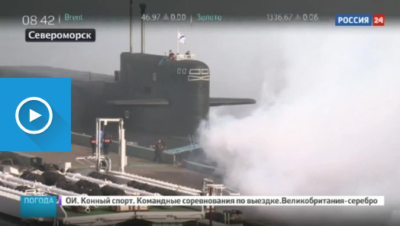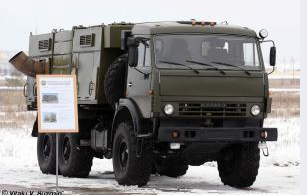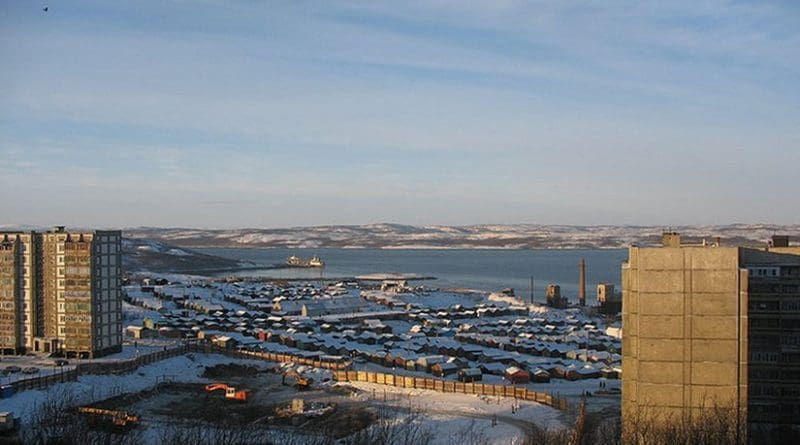Why Is Russia Blowing Smoke (Literally)? The Military Uses Of Artificial Fog – Analysis
By Published by the Foreign Policy Research Institute
The artificial fog—called “smoke” (dyma) in some reports—is said to be an aerosol that Russian armed forces were testing to assess its effectiveness in concealing military (in this case, naval) assets.
By John R. Haines*
(FPRI) —“The fog comes on little cat feet.
It sits looking over harbor and city
on silent haunches and then moves on.” — Carl Sandburg, Fog
Russian armed forces caused the closed city of Severomorsk[1] to “plunge into the fog” for three days (10-12 August), reported Novosti Kratko and other Russian language news portals.[2] Special-purpose “stationary and mobile smoke screening (dymopuska)” devices[3] operated by the Radiation, Chemical, and Biological Defense Troops[4] generated the chemical fog that blanketed the Northern Fleet’s homeport.

The artificial fog—called “smoke” (dyma) in some reports—is said to be an aerosol that Russian armed forces were testing to assess its effectiveness in concealing military (in this case, naval) assets. Other reports reference “radiation, chemical and biological protection,” implying the aerosol may have some unspecified prophylactic quality.
The Russian media portal Vesti published this screenshot from a broadcast on the Russian government-owned Rossiya-24, which carried the caption “Chemical defense troops make the Northern Fleet’s naval base disappear.”[5]

The report continued:
“Assessments of aerosol masking continue in Severomorosk. For a few hours, all ships in the floating base led by the heavy missile cruiser Pyotr Velikiy disappeared into an impenetrable fog.”[6]
Russia’s TV21 broadcast footage of Russian troops “putting up a smokescreen and camouflaging the base” from which these screenshots were taken:[7]

An accompanying commentary claimed the Russian troops were capable of putting up a cloud one kilometer in radius, which they could sustain for up to fourteen hours.
So what is happening? Reports that “the Russian armed forces will conceal the whole city for three days” and “the Northern Fleet at Severomorsk will be hidden”[8] imply the use of an obscurant smoke, the literal “fog of war” (tuman voyny). Obscurant smoke is an aerosol cloud brought into the line of sight between an observer and a target. Obscurants are not considered chemical weapons. Rather, they are classified as military chemical compounds even though some have toxic effects. These toxic smokes (sometimes called combination smoke) include tear gas or other chemical agents that can degrade electro-optical devices in the visual and infrared wavebands.[9]
Obscurants function as a combat multiplier, the purpose of which is to screen or blind, and, sometimes, to deceive (a decoy screen).[10] Obscurants are useful, for example, to counter an adversary’s asymmetric advantages in an urban battlespace by concealing a ground unit as it moves through terrain. The United States Marine Corps concluded from its study of Russian combat operations in Chechnya that “Obscurants are especially useful when fighting in cities.”[11] The most common obscurant generators vaporize low viscosity petroleum distillates to produce a stable petroleum smoke cloud of extremely small diameter droplets that scatter light rays. Modern obscurants such as synthetic graphite flakes can screen electromagnetic tracking and targeting systems, and frustrate sensors in the near-, mid- and far-infrared bands.
There is nothing novel about the use of obscurants. For thousands of years, military forces have used smoke screens to conceal movement and to frustrate enemy targeting. A century ago, white phosphorus and other types of smoke were the focal point of experiments by the Army’s new Chemical Warfare Service, which was formed in June 1918. In World War II, the United States deployed some 40 smoke generator units that were used to defend sites against air attacks—for example, concealing Allied naval formations around Bizerte, Tunisia, from Axis aircraft—and experimentally to conceal aircraft inflight at assembly areas from ground-based anti-aircraft defenses.[12] Smoke generators were deployed during the Korean War to form a defensive screen over Pusan’s port facilities, and to screen the amphibious landing at Inchon. While the use of obscurants was much reduced in Vietnam, three decades later during Operation Desert Shield, the United States Army 59th Chemical Company conducted a large area-screening mission around Saudi Arabia’s King Fahd International Airport.
Modern multi-spectral obscurants are used to defeat enemy reconnaissance, surveillance, and target acquisition systems that operate in the visual, infrared, and millimeter wave regions of the electromagnetic spectrum. It is possible for a force to achieve full dominance of the electromagnetic spectrum by means of full-spectrum obscuration and other signature reduction methods. The United States deploys several systems, including the M56/M56E Smoke Generator Set (SGS) [NATO reporting name: Coyote],[13] the M58 Mechanized Smoke Obscurant System [NATO reporting name: Wolf],[14] the M157/M157A2 SGS [NATO reporting name: Lynx],[15] and the M1059/M1059A3 Smoke Generator Carrier (SGC).
![Exercise Pandarra Fog (2014) U.S. Navy 7th Fleet and the Navy Warfare Development Command Test Radar-Absorbing Carbon-Fiber Obscurant Technology (Source:United States Navy) Exercise Pandarra Fog (2014) U.S. Navy 7th Fleet and the Navy Warfare Development Command Test Radar-Absorbing Carbon-Fiber Obscurant Technology (Source:United States Navy[18])](http://www.eurasiareview.com/wp-content/uploads/2016/09/Haines-Foggy-Day-081916-5-400x285.png)
That is not to say obscurants have no role in concealing preparations for offensive action. A provocative February l955 article by Marshal Pavel Rotmistrov published in the Soviet journal Voyennaya misl’ (“Military Thought”) addressed the question of surprise (the context was nuclear weapons, but the principle holds as a general rule). “While surprise cannot yield conclusive results,” he wrote, it is “one of the decisive conditions for attaining success, in battle and operations as well as the war as a whole.”[19] Here the role of obscurants is to conceal preparations for a preemptive strike:
“[Surprise] is achieved by confusing the enemy about your intentions for battle, and by keeping secret your intentions, and by concealing your preparations for battle.”
The Russian word maskirovka is usually translated as “deception”[20] (and sometimes, as “camouflage”) although the Sovetskaya Voyennaya Entsiklopediya (“Soviet Military Encyclopedia”) defined it as voyennyy khitrost’ (“strategems”). The second word of this definitional term—khitrost’—means cunning, in the sense Clausewitz used it when he wrote, “the term ‘cunning’ implies secret purpose.”[21] Soviet doctrine employed maskirovka-as-camouflage “to conceal the true position of our troops from the enemy and to mislead him about it, and by so doing, to lead him to commit mistakes and to make erroneous conclusions about the situation.”[22] It is multi-dimensional—time, scope, scale, and the character of military operations. Maskirovka-as-camouflage employs three types of obscurants—concealing, blinding, and decoying smoke.[23]
According to the Reagan-era National Security Decision Directive Number 108 dated 12 October 1983, the “doctrine of maskirovka” calls for “the use of camoflage [sic], concealment and deception (CC&D),” the “measures” of which are “concealment, simulation, diversionary actions and disinformation.”[24] The recent conflict in eastern Ukraine illustrates their application in the post-Soviet era in conjunction with military force and non-military means of influence:
“Moscow concentrated forces, waged deception operations, conducted alert exercises and snap inspections in various military districts to disorient neighboring states, to divert their attention, and, often, to conceal the direction of the main effort.”[25]
This, of course, is nothing new: the use of obscurants long was a basic tenet of Soviet urban warfare doctrine:
“Smoke agents are used to conceal the maneuver of men and weapons between strong points, defensive areas, and separate buildings not having concealed or underground routes between them and also to prevent the enemy from observing and conducting aimed fire.”[26]
A 1978 United States Defense Intelligence Agency report noted a more ominous use: the use of protecting smoke—which attenuates energy weapons on the battlefield—to reduce battlefield levels of thermal radiation after a nuclear detonation.[27] The United States Marine Corps Fleet Marine Force Manual No. 11-9 states much the same:
“In an active nuclear environment or when the threat of nuclear weapons use is high, smoke can be used to attenuate the thermal energy effects from nuclear detonations. Chemical smoke units can provide this asset to a commander if they are available.”[28]
So, too, the United States Army publication Mechanized Infantry Squad Operations: “Fog or heavy battlefield smoke can reduce the effects of thermal radiation.”[29] Protective and obscurant smoke can both be used to degrade the effect of directed energy weapons such as lasers, high-power microwaves, particle beams, and non-nuclear directed electromagnetic pulse.[30]
While Severomorsk’s three-day “fog” was most likely a simple obscurant, the use of protective and obscurant smoke for radiation, chemical and biological protection is an intriguing—and if true—far more troubling explanation. The containment and neutralization of chemical and biological agents released in an explosive detonation[31] presents significant technical challenges. Most chemical (CWA) and biological (BWA) warfare agents are in the form of a liquid or vapor that is dispersed into the environment as an aerosol or gas.[32] These agents can be anti-personnel—both lethal ones and incapacitants (which include non-CWA toxic smoke)—and anti-material—corrosive chemicals, for example, or microbes capable of degrading material such as carbon fiber, cement or fuel. CWA and BWA defense involves thermal and chemical destructive methods to contain and neutralize agent(s). One of the biggest challenges to counter the effect of a CWA or BWA detonation is to contain and/or neutralize large fractions of the released agent(s). Concealment, the United States Army Field Manual states, is key to a force’s “ability to protect itself against NBC [nuclear, biological and chemical] weapons and to operate in contaminated environments.”[33] While obscurants are not CWA, the availability of both “toxic and neutral smokes” is useful as an offensive measure “to force the enemy to use chemical protection systems, thus lowering its effectiveness.” Moreover, “Camouflage, blinding, and decoy smokescreens are useful in concealing the direction and time of attack.”
Russia: Blowing Smoke in Whose Eyes?[34]
The deployment of an aerosol obscurant over the Northern Fleet’s Severomorsk base occurred at the same time that Voyska RKHBZ [Radiation, Chemical, and Biological Defense] forces conducted a radiological and chemical decontamination exercise with Baltic Fleet forces around Kursk.[35] In early August, Voyska RKHBZ forces were visibly present in Armenia, reportedly engaged in “testing new sensors”:[36]
“in the mountainous terrain in the highlands in order to detect signs of a chemical or biological attack at a distance of 6 kilometers and to identify radioactive contamination over an area of 10 square kilometers, while remotely transmitting information about the weather and any detected back to the command post.”[37]

And in Transnistria, Voyska RKHBZ trainers were part of a 500 person training exercise in July “on protecting against the damaging effects of weapons of mass destruction.”[38]
It is of course customary for specialized units like Voyska RKHBZ to train with other units, but their appearance in chronic hotspots like Armenia and Transnistria is attention getting nonetheless. A recent profile in RussiaToday News discussed the TDA-3 Smoke Vehicle:
“The TDA-3 is used for the production of aerosol curtains. It can do so to camouflage major military installations and military equipment as well as military personnel engaged in fording rivers. A key feature is the aerosol curtain’s ability to work effectively not only in the visible range but also the infrared range, and to provide not only ground cover but also an elevated veil that can cover bridges and oversized objects.”[39]
Given the place of obscurant and protective smoke in Russian (and earlier, Soviet) military doctrine, and Russia’s demonstrated willingness today to intervene militarily in its near abroad, the cumulative weight of recent events—the large-scale test of obscurants over the Northern Fleet’s homeport, radiological and chemical weapon decontamination exercises with the Baltic Fleet, the visible presence of specialized troops in place like Transnistria and Armenia—send an intentional signal to Ukraine and other neighboring countries in addition to serving a practical purpose.
Maxim Trudolyubov wrote in a recent Moscow Times commentary:
“Putin is a proven master at manipulating emergencies—real or imagined—to reach his political end. […] What has changed is the scale. Moscow has been demonstrating lately that it can keep most of its immediate region and its partners and opponents in a state of alarm.”[40]
Especially given Russia’s past use of “training exercises” to mask offensive action, each of these events—from dramatic ones like hiding the Northern Fleet to the appearance of specialized troops in known hotspots—merits close and continuous scrutiny going forward.
The translation of all source material is by the author unless noted otherwise.
About the author:
*John R. Haines is Co-Director of the Foreign Policy Research Institute’s new Eurasia Program and Executive Director of FPRI’s Princeton Committee. Much of his current research is focused on Russia and its near abroad, with a special interest in nationalist and separatist movements. As a private investor and entrepreneur, he is currently focused on the question of nuclear smuggling and terrorism, and the development of technologies to discover, detect, and characterize concealed fissile material. He is also a Trustee of FPRI.
Source:
This article was published by FPRI
Notes:
[1] Severomorsk is a ZATO [the transliterated acronym of zakrytyye administrativno-territorial’nyye obrazovaniya] or “closed administrative-territorial formation.” Part of the Murmansk Oblast, it is located on the Barents Sea’s Kola Bay about 26 km from the city of Murmansk. The city is home to the Russian Northern Fleet’s main administrative base. In 1933 it was a small sparsely inhabited settlement known as Vayenga when it was designated a forward base for the newly created Northern Fleet. Its name is a portmanteau word formed from sever [Russian: север. English: north] and more [Russian: море. English: sea] and was adopted as the city’s name in 1951.
[2] “Severomorsk zamaskiruyut: tselyy gorod na tri dnya pogruzyat v tuman.” Novosti Kratko [published online in Russian 10 August 2016]. http://novostikratko.ru/murmansk/2016/08/10/324375-severomorsk-zamaskiruyut-tselyj-gorod-na-tri-dnya-pogruzyat-v-tuman.html. Last accessed 11 August 2016.
[3] MK.ru (9 August 2016), op cit.
[4] The responsibilities of the Radiation, Chemical, and Biological Defense Troops of the Armed Forces [Russian transl.: Voyska radiatsionnoy, khimicheskoy i biologicheskoy zashchity or Voyska RKHBZ] include the deployment of aerosols to camouflage troops and facilities and to frustrate precision-guided weapons and reconnaissance; and radiological, chemical and biological containment and decontamination.
[5] “Pogoda 24: tuman voyny.” Vesti.ru [published online in Russian 13 August 2016]. http://www.vesti.ru/videos/show/vid/688749/cid/7/#. Last accessed 14 August 2016.
[6] Ibid. The Pyotr Velikiy (“Peter the Great”) is a Project 1144.2 battlecruiser NATO designation: Kirov-class commissioned in 1995 and the Northern Fleet’s flagship. It is not the submarine shown in the screenshot but instead this one shown in as RIA-Novosti photograph:
The Pyotr Velikiy
[7] “Ushli v tuma.” TV21 [published online in Russian 12 August 2016]. http://www.tv21.ru/news/2016/08/12/ushli-v-tuman. Last accessed 13 August 2016.
[8] Novosti Kratko (10 August 2016), op cit.
[9] United States Army (2011). TC 7-100.2. Opposing Force Tactics. Chapter 13. CBRN and Smoke.
[10] Ernst-Christian Koch (2008). “Special Material in Pyrotechnics: V. Military Applications of Phosphorus and its Compounds.” Propellants, Explosives, Pyrotechnics. 33:3 (June 2008) 165. There are hygroscopic (e.g., red and white phosphorus, hexachloroethane) obscurant aerosols, which means they absorb water from the atmosphere; and non-hygroscopic (e.g., carbonaceous soot and brass particles) obscurant aerosols. The performance of hygroscopic aerosols is always dependent on the relative humidity which itself is a function of the ambient temperature.
[11] United States Department of the Army (2002). Combined Arms Operations in Urban Terrain. FM 3-06.11 (FM 90-10-1) H-3. See: APPENDIX H. Lessons Learned From Modern Urban Combat, H-1. Russia and the War in Chechnya, b. US Marine Corps Analysis, (3) Tactical Lessons, subheading (g). http://www.bits.de/NRANEU/others/amd-us-archive/fm3-06.11(02).pdf. Last accessed 15 August 2016.
[12] The United States War Department’s Military Intelligence Division prepared multiple assessments of German, Italian and Japanese experimental and operational uses of defensive and offensive smoke, smoke weapons, and smoke generators. See for example: United States War Department Military Intelligence Division (1943). Tactical and Technical Trends. Nos. 7, 18, 20, 23, 24, 25, 32, 35, 36, 38, and 40.
[13] The M56/M56E is the United States Army’s first visual and infrared large area smoke generating system. It works by means of “Fog oil pumped into the exhaust gas of a turbine engine to produce visual obscuration and graphite pellets are pulverized to 5 micron particles and disseminated through a separate ejector to produce infrared obscuration.” Edgewood Chemical Biological Center (2009). CBRN Handbook. (Rock Island, IL: Edgewood Chemical Biological Center) 152.
[14] Ibid., 153.
[15] ” The M157A2 uses dual pulse jet engines, operating on standard Army fuels, to produce large white clouds of fog oil vapor which defeat visual-range observation and tracking methods, including lasers.” Ibid., 154.
[16] Thomas J. Culora (2010). “The Strategic Implications of Obscurants.” Naval War College Review. 63:3 (Summer 2010) 74.
[17] Ibid.
[18] http://www.navy.mil/view_imagex.asp?id=180261&t=1. Last accessed 9 August 2016.
[19] Pavel A. Rotmistrov (1955). “O roli Neozhidannosti v sovremennoy voyne.” Voyennaya misl’. 2 (February 1955).
[20] See for example: U.S. Department of Defense (1983). Lexicon of Selected Soviet Terms Relating to Maskirovka (Deception). Intelligence Document No. DDB-2460-3-83 (Washington, D.C.: Defense Intelligence Agency) 4.
[21] Carl von Clausewitz (1832; 1976). On War, Michael Howard & Peter Paret, eds. & transls. (Princeton: Princeton University Press) 202.
[22] General-Major Vasiliĭ Gerasimovich Reznichanko (1966). Taktika. (Moskva: Voyennoye Izdatel’stvo hinisterstva Oborony, SSSR) 148. Later editions of the book were translated and published by the United States State Department Translation Bureau and the United States Air Force, respectively.
[23] A. A. Beketov, A. P. Belekon & S. G. Chermashentsev (1976). Maskirovka Deystviy Podrazdeleniy Sukhoputnykh Voysk. (Moskva: Voyennoye izdte’ stvo Ministerstva Oborony, SSSR) 82-83.
[24] https://fas.org/irp/offdocs/nsdd/nsdd-108.pdf. Last accessed 16 August 2016.
[25] Dmitry Adamsky (2015). “Cross-Domain Coercion: The Current Russian Art of Strategy.” Proliferation Papers 54, The Institut Français des Relations Internationales. 37. http://www.ifri.org/sites/default/files/atoms/files/pp54adamsky.pdf. Last accessed 16 August 2016.
[26] A.K. Shovkolovich, F.I. Konasov, and S.I. Tkach (1971). Boyevyye deystviya motostrelkovoy batal’ona v gorode. (Moskva: Voyennoye izdte’ stvo Ministerstva Oborony, SSSR).
[27] United States Defense Intelligence Agency (1978). Soviet/Warsaw Pact Ground Force Camouflage and Concealment Techniques. DDI-1100-161-78 (January 1978). (Washington, D.C.: Defense Intelligence Agency) 24.
[28] United States Marine Corps (1992). Fleet Marine Force Manual No. 11-9 (29 May 1992), “Nuclear Protection.” http://www.globalsecurity.org/wmd/library/policy/army/fm/3-4/Ch4.htm. Last accessed 16 August 2016. See also United States Army (1994). Field Manual 3-101-1. Smoke Squad/Platoon Operations (23 September 1994)1-4.
[29] http://www.globalsecurity.org/military/library/policy/army/accp/in0202/le2k.htm. Last accessed 16 August 2016.
[30] United States Army (1990). Smoke Operations. Field Manual 3-50 (4 December 1990)13. http://www.bits.de/NRANEU/others/amd-us-archive/fm3-50(90).pdf. Last accessed 16 August 2016.
[31] The United Nations has used the term weapon of mass destruction since 1947, which it defines as “atomic explosive weapons, radioactive material weapons, lethal chemical and biological weapons, and any weapons developed in the future which have characteristics comparable in destructive effect to those of the atomic bomb or other weapons mentioned above.” Its first documented use precedes the earliest nuclear weapons and modern bioweapons, dating to a December 1937 radio broadcast by William Lang, Archbishop of Canterbury, in which he condemned the aerial bombing of Spanish and Chinese cities. Parts of his broadcast were reprinted as a commentary in The Times, including this one: “Who can think without horror of what another widespread war would mean, waged as it would be with all the new weapons of mass destruction?”
[32] There is some indication that the People’s Liberation Army has assessed the use of protective or obscurant smoke for CWA protection.
[33] United States Army (1998). FM 100-61. Armor- and Mechanized-Based Opposing Force Operational Art. (Washington, D.C.: Headquarters, Department of the Army). See: Chapter 14, “NBC and Smoke Support.” http://www.globalsecurity.org/military/library/policy/army/fm/100-61/index.html. Last accessed 15 August 2016.
[34] From the traditional Russian saying Puskat’ dym v glaza (“Let smoke blow in his eyes”).
[35] “Podrazdeleniye RKHBZ Baltiyskogo flota na uchenii v Kurskoy oblasti otrabatyvayet deystviya pri likvidatsii posledstviy tekhnogennykh avariy.” Minoborony Rossii [published online 11 August 2016]. http://function.mil.ru/news_page/country/more.htm?id=12092613@egNews&utm_source=twitterfeed&utm_medium=twitter. Last accessed 13 August 2016.
[36] “Podrazdeleniye RKHBZ rossiyskoy voyennoy bazy v Armenii pristupili k zanyatiyam na vysokogornom poligone Kamkhud.” Minoborony Rossii [published online 1 August 2016]. http://function.mil.ru/news_page/country/more.htm?id=12091330@egNews. Last accessed 13 August 2016.
[37] “V Armenii nachalsya polevoy vykhod podrazdeleniya RKHBZ Yuzhnogo voyennogo okruga.” Novosti-Armeniya [published online in Russian 1 August 2016]. http://newsarmenia.am/news/armenia/v-armenii-nachalsya-polevoy-vykhod-podrazdeleniya-rkhbz-yuzhnogo-voennogo-okruga/. Last accessed 13 August 2016.
[38] “V OGRV nachalis’ ucheniya po biologicheskoy i khimicheskoy zashchite.” Novosti Pridnestrov’ya [published online in Russian 7 July 2016]. http://novostipmr.com/ru/news/16-07-07/v-ogrv-nachalis-ucheniya-po-biologicheskoy-i-himicheskoy-zashchite. Last accessed 14 August 2016].
[39] “Perspektivy razvitiya voysk RKHBZ Rossii.” RussiaToday News [published online in Russian 9 August 2016]. http://russiatodaynews.ru/2016/08/09/perspektivy-razvitija-vojsk-rhbz-rossii/. Last accessed 14 August 2016.
[40] Maxim Trudolyubov (2016). “It’s Security, Stupid: How Putin Manipulates National Emergencies.” The Moscow Times [published online 15 August 2016]. https://themoscowtimes.com/articles/its-the-security-stupid-54982. Last accessed 17 August 2016.

